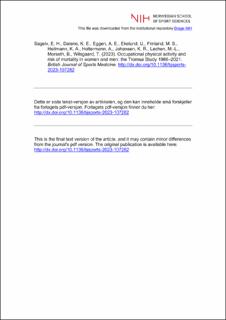Occupational physical activity and risk of mortality in women and men: the Tromsø Study 1986–2021
| dc.contributor.author | Sagelv, Edvard Hamnvik | |
| dc.contributor.author | Dalene, Knut Eirik | |
| dc.contributor.author | Eggen, Anne Elise | |
| dc.contributor.author | Ekelund, Ulf | |
| dc.contributor.author | Fimland, Marius Steiro | |
| dc.contributor.author | Heitmann, Kim Arne | |
| dc.contributor.author | Holtermann, Andreas | |
| dc.contributor.author | Johansen, Kristoffer Robin | |
| dc.contributor.author | Løchen, Maja-Lisa | |
| dc.contributor.author | Morseth, Bente | |
| dc.contributor.author | Wilsgaard, Tom | |
| dc.date.accessioned | 2024-01-12T12:03:51Z | |
| dc.date.available | 2024-01-12T12:03:51Z | |
| dc.date.created | 2023-11-02T01:18:38Z | |
| dc.date.issued | 2023 | |
| dc.identifier.citation | British Journal of Sports Medicine. 2023, 58(2), 81-88. | en_US |
| dc.identifier.issn | 0306-3674 | |
| dc.identifier.uri | https://hdl.handle.net/11250/3111301 | |
| dc.description | I Brage finner du siste tekst-versjon av artikkelen, og den kan inneholde ubetydelige forskjeller fra forlagets pdf-versjon. Forlagets pdf-versjon finner du på bjsm.bmj.com / In Brage you'll find the final text version of the article, and it may contain insignificant differences from the journal's pdf version. The definitive version is available at bjsm.bmj.com | en_US |
| dc.description.abstract | Objective: Associations between occupational physical activity (OPA) and mortality risks are inconclusive. We aimed to examine associations between (1) OPA separately and (2) jointly with leisure time physical activity (LTPA), and risk of all-cause, cardiovascular disease (CVD) and cancer mortality, over four decades with updated exposure and covariates every 6–8 years. Methods: Adults aged 20–65 years from the Tromsø Study surveys Tromsø3-Tromsø7 (1986–2016) were included. We categorised OPA as low (sedentary), moderate (walking work), high (walking+lifting work) or very high (heavy manual labour) and LTPA as inactive, moderate and vigorous. We used Cox/Fine and Gray regressions to examine associations, adjusted for age, body mass index, smoking, education, diet, alcohol and LTPA (aim 1 only). Results: Of 29 605 participants with 44 140 total observations, 4131 (14.0%) died, 1057 (25.6%) from CVD and 1660 (40.4%) from cancer, during follow-up (median: 29.1 years, 25th–75th: 16.5.1–35.3). In men, compared with low OPA, high OPA was associated with lower all-cause (HR 0.83, 95% CI 0.74 to 0.92) and CVD (subdistributed HR (SHR) 0.68, 95% CI 0.54 to 0.84) but not cancer mortality (SHR 0.99, 95% CI 0.84 to 1.19), while no association was observed for moderate or very high OPA. In joint analyses using inactive LTPA and low OPA as reference, vigorous LTPA was associated with lower all-cause mortality combined with low (HR 0.75, 95% CI 0.64 to 0.89), high (HR 0.67, 95% CI 0.54 to 0.82) and very high OPA (HR 0.74, 95% CI 0.58 to 0.94), but not with moderate OPA. In women, there were no associations between OPA, or combined OPA and LTPA, with mortality. Conclusion: High OPA, but not moderate and very high OPA, was associated with lower all-cause and CVD mortality risk in men but not in women. Vigorous LTPA was associated with lower mortality risk in men with low, high and very high OPA, but not moderate OPA. | en_US |
| dc.language.iso | eng | en_US |
| dc.subject | cardiovascular diseases | en_US |
| dc.subject | epidemiology | en_US |
| dc.subject | observational study | en_US |
| dc.subject | physical activity | en_US |
| dc.title | Occupational physical activity and risk of mortality in women and men: the Tromsø Study 1986–2021 | en_US |
| dc.title.alternative | Occupational physical activity and risk of mortality in women and men: the Tromsø Study 1986–2021 | en_US |
| dc.type | Peer reviewed | en_US |
| dc.type | Journal article | en_US |
| dc.description.version | acceptedVersion | en_US |
| dc.source.pagenumber | 10 | en_US |
| dc.source.journal | British Journal of Sports Medicine | en_US |
| dc.identifier.doi | 10.1136/bjsports-2023-107282 | |
| dc.identifier.cristin | 2191268 | |
| dc.description.localcode | Institutt for idrettsmedisnske fag / Department of Sports Medicine | en_US |
| cristin.ispublished | true | |
| cristin.fulltext | postprint | |
| cristin.fulltext | postprint | |
| cristin.qualitycode | 2 |
Tilhørende fil(er)
Denne innførselen finnes i følgende samling(er)
-
Artikler / Articles [2096]
-
Publikasjoner fra Cristin [1084]
